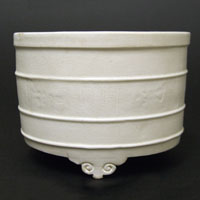
A 17th Century Blanc de Chine Porcelain Censer, Late Ming or Early Qing.
A Ming or Early Qing Blanc de Chine porcelain Lian, censer, Chongzhen Period or early Shunzhi c.1630 -1650. The circular archaic bronze form with concentric banding with an impressed Leiwen design. This late Ming Dynasty or Qing incense burner is supported on three small bracket shaped feet, representing Ruyi-Heads.
SOLD
- Condition
- In perfect condition.
- Size
- Diameter : 12.5 cm (5 inches)
- Provenance
- R and G McPherson Antiques. From a Private European Collection of Antique Chinese Porcelain.
- Stock number
- 24813
- References
- For two Blanc de Chine Ming porcelain censers of this form see : Blanc de Chine (Introduction by John Ayers, S.Marchant & Son, 2006. ISBN 0-9554009-0-2) page 113, plates 75, 75a. A further very similar Ming porcelain censer see : Exhibition of Blanc de Chine (S.Marchant & Son, 1994) page 64, plate 98. For two other related Ming porcelain blanc de chine censers see : Blanc de Chine, Porcelain From Dehua, A Catalogue of the Hickley Collection, Singapore (Rose Kerr & John Ayers, Art Media Resources Ltd, 2002) items 77 an 78. For a further Ming porcelain censer see : Blanc de Chine (P.J. Donnelly, Faber and Faber, 1969, ISBN 571-08078-2) plate 19 B. Blanc de Chine censers of this form were recovered from the Hatcher Cargo of c.1643. It appears there were only four blanc de chine censers sold from the Hatcher Cargo, see : Fine And Important Late Ming And Transitional Porcelain, Recently Recovered from an Asian Vessel in the South China Sea. Property of Captain Michael Hatcher. Christie`s Amsterdam 14th March 1984, lots 299 to 302. Also see : The Hatcher Porcelain Cargoes, The Complete Record (Colin Sheaf and Richard Kilburn, Phaidon 1988. ISBN 0-7148-80469) page 73, plate 113.
Information
Blanc de Chine Porcelain :
The porcelain known in the West as Blanc de Chine was produced 300 miles south of the main Chinese kiln complex of Jingdezhen. The term Blanc de Chine refers to the fine grain white porcelain made at the kilns situated near Dehua in the coastal province of Fujian, these kilns also produced other types of porcelain. A rather freely painted blue and white ware, porcelain with brightly coloured `Swatow` type enamels as well as pieces with a brown iron-rich glaze. However it is the white blanc de Chine wares that have made these kilns famous. The quality and colour achieved by the Dehua potters was partly due to the local porcelain stone, it was unusually pure and was used without kaolin being added. This, combined with a low iron content and other chemical factors within the body as well as the glaze, enabled the potters to produce superb ivory-white Blanc de Chine porcelain.
Censers :
Chinese censers have a long history, they are thought to have originated in the Eastern Zhou dynasty (770 - 256 B.C.). They are normally association with paying reverence to ancestors, the smoke omitted was thought to be a way for the living to communicate with the spirit of the dead. However, from early times there have been different censers for different functions including fumigation and even pest control. They also occur in many different forms. During the Western Han dynasty Western Han (206 B.C. - A.D. 8) the Boshan Xianglu universal mountain censer was developed. These bronze censors had elaborate craggy mountain peaked covers which aloud the incense smoke to waft out of naturalistically rendered holes, like so many bronze forms they were copied by potters who made lead-glazed pottery versions. The incense cones that created this smoke were made from plants, including magnolia, grasses and lovage, however early Taoists might have preferred something stronger, adapted censers for the religious and spiritual use of cannabis. Yuan, Ming and Qing dynasty ladies at court used novelty censers to fumigate new cloths, a Yuan poem includes the lines "The incense continues burning in the golden duck censor `til midnight, as court ladies keep trying on their new garments of silk and muslin". For a Ming dynasty bird form celadon censer see sold items stock number 18026. Most Chinese censer are, however, of circular form and sit on three low feet, the interior is unglazed and left in a biscuit state. Some of the Yuan and Ming celadon censers have impressed decoration to this biscuit area. Sand was placed inside the censer and josticks or cones were used. Many family`s had an alter at home where rituals were performed and respect was paid to their ancestors, incense burners were an important object in this context, often forming part of an alter garniature with a pair of vases. Indeed we know from the inscription on the famous `David Temple` vases now at the British Museum, not only that they were made in the year 1351, but that there was originally a censer with them, unfortunately now lost, (for an illustration of these important Yuan vases see our `Links` section, where they are shown next to the link to the British Museum website where you can read more about them). Because of there ritual use, censers, like the missing David censer, were sometimes commissioned for a specific temple or other building. They person commissioning them sometimes had a dedicatory inscription added. For example the Dehua blue and white censer, stock number 19766 (see `Sold` items). This has an inscription that mentions the name of the family who presented it, as well as the temple the piece was given to, along with a date, the twelfth year of Qianlong (1736 - 1795) equivalent to 1748. It also asks for more children and riches. China`s renewed connection with its spiritual past has meant that censers are once again being lit across the land.
A very similar Ming porcelain Blanc de Chine censer recovered from the Hatcher Cargo of c.1643.
Sold by R and G McPherson Antiques number 22482.





